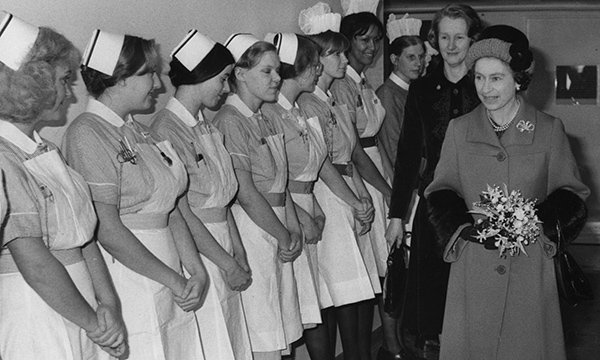Honor Queen Elizabeth II by Supporting Nurses
Photo Caption and Credit: “Nurses make a guard of honour at St Thomas’ Hospital in London, where the Queen opened the 14-storey North Wing in 1976.” (RCNi)
With Queen Elizabeth II's passing this week, media coverage has focused on her 70 years of loyal public service and her family's complicated legacy around the world. Royalists and anti-monarchists may disagree politically, but they might both acknowledge that Queen Elizabeth II's devotion to nearly 600 charities deserves recognition. One of her earliest patronages, The Royal College of Nursing, merits discussion this week as global nursing shortages are once again in the news. Typically, this is discussed as a labor problem in high-income countries, but according to global data, this impacts low-wealth countries even more. How did this happen, and what can we do to support the field of nursing?
Pre-pandemic global nursing shortage.
In 2020, the World Health Organization (WHO) released the first State of the World's Nursing report. According to their data, at the time, there were almost 28 million nurses globally, nearly 6 million fewer than what WHO believes are needed. WHO found that 89% of the nursing shortages were in low and lower-middle-income countries, "with huge gaps in countries in the African, South-East Asia, and Eastern Mediterranean WHO regions." In the next decade, an estimated 17% of nurses are expected to retire, and a little less than 5 million nurses will be needed to replace them. Given estimated impacts due to retirement, WHO believes that "10.6 million additional nurses will be needed by 2030."
Why some nurses are retiring now.
The International Council of Nurses (ICN) has been trying to track retention data but has acknowledged information by country is sparse. What they have found, however, is that today trauma, stress, and occupational infections have exacerbated the existing nursing shortage. For example, in the United Kingdom (UK), the National Health Service (NHS) reported that "36% of the current [nursing] workforce considered leaving in 2021." Nurses in South Korea who treated COVID-19 patients were reportedly less likely to wish to continue in the field. In the Philippines, research shows that "prolonged distress from the pandemic enhanced psychological anxiety and turnover intention among nurses." An Egyptian study showed that more than 95% of nurses at a COVID-19 Triage Hospital intended to leave their jobs, and 25% considered leaving nursing altogether. Similarly, in Qatar, exposure to COVID-19 patients has been a predictor of attrition in nursing.
Some aspiring nurses choose other fields.
In the U.S., there are more aspiring nurses than there are places in schools for them to study. The Center for American Progress's (CAP) 2022 report "How To Ease the Nursing Shortage in America" states that "capacity within higher education is significantly lower than what is needed." By examining the last academic year, CAP found that universities were unable to enroll 66,000 qualified nursing applicants simply because of "program constraints." CAP found three main issues that led to those institutional constraints: "a shortage of nurse educators, a lack of clinical placements for student nurses, and inadequate campus facilities and equipment."
Support expanding access to nursing education. At the end of their 2022 report on the critical nursing shortage, CAP recommends that the U.S. Congress pass the Future Advancement of Academic Nursing (FAAN) Act, which was introduced in the House by Rep. Lauren Underwood (D-IL-14). This bill would ensure that competitive grants are awarded to nursing schools to expand education, increase the capacity to respond to public health crises, and diversify the pool of nurses and nursing educators. While that is one step being considered in the U.S., globally, governments need to find solutions and answer WHO's request to increase the number of nurses through investing in education and retention programs. No matter where you are located, please consider championing nursing education in your country. To learn more about existing nursing data in your nation, register for WHO's National Health Workforce Accounts Data Portal and read WHO's latest report.



